In a Nutshell: Why these are Ultimate tents
As you go through the descriptions and specs of the MoonLights, it’s pretty easy to see that these are excellent tents. Well and truly thought out and impeccably executed by the world's top factory. Why would TheTentLab's owner, Mike Cecot-Scherer, a tent designer by trade with forty six years of experience, make and sell anything else? Once you’ve explored the MoonLight's design details and features, once you're convinced that I’ve done a bang-up job, the next question is “OK, top level, what's the most important betterness we're selling here?”
This page is the top-level beta on what’s better, the top problems we’ve solved that others either don’t know enough to fix or have simply chosen to ignore. It's a hard list to make. For instance, backpackers in alpine terrain hardly ever wear out their zippers, but it's an ever-present threat in the desert and on river trips…and so on.
• I'm pretty sure the 2+ is the strongest 3-season tent ever made.
If camping is part of your lifestyle, something that you do regularly and for a long time, then freak windstorms, and diluvial rains are not freakish at all – you've probably had them before and you know that you'll have them again. These tents are built with great attention to strength and performance in all directions: they deal with freak, harsh, infrequent but inevitable conditions – providing nearly winter-tent levels of strength at far lower weights (and they're vastly cooler in hot weather). Once you become used to their capabilities, you'll experience a shift in the types of campsites you're drawn to because the most spectacular campsites are always the most exposed. With the MoonLights: GO THERE, camp, enjoy.
I should also mention that there is, I think, a general belief that the most challenging weather is in the mountains, but this is simply not true in the US - and I'm not just talking about tornados in Oklahoma. Generally speaking, microbursts and other freak winds are much more common in the deserts and plains than in the mountains.
For instance, the Sierra Nevada, like most of California, has incredibly gentle weather most of the time. You can backpack there for months in Summer and never see a fierce windstorm. If you're lucky you might see one good thunderstorm.
The Rocky Mountains cover a big area and they are indeed generally windy and thunderstorms are frequent (every afternoon like clockwork is quite common). But they're not as freaky – they rarely change from breezy to pounding in just a few minutes.
On the other hand, spend a couple of months in the high deserts of the SouthWest or the prairies of Colorado and Wyoming and who-boy is that another story: you'll see plenty of freak wind events that come and go with bewildering speed; you'll see thunderstorm after spectacular thunderstorm, maybe even a flash flood or two.
TheTentLab's location in Colorado and our playing in the high deserts of Utah as well as in our local mountains explains our priorities pretty well: we don't find ultralight tents at all satisfactory for our precious outdoor time. In Utah, make that double because we base out of remote car-camps where we often have no cover at all from the full force of the weather. AND we leave the tents up untended every day as we explore slot canyons, anasazi ruins and search for petroglyphs. Like this camp next to the San Rafael Swell:

If this were a campground it would be getting lots of 1-star reviews along these lines: "Bald and completely exposed," "Horrible, not even a stick for a tree,"Ground barely takes stakes," and so on. Since it was just us, alone for miles, and our tent could be trusted to be there intact when we got back from a day's exploring: "Fantastic 360˚ views, close to slot canyons and petroglyphs, smooth and flat, 5-stars (bring the sunshade)."
Handling difficult conditions is what makes the MoonLights so good for international trips to wild weather places like the tent-spanking Torres Del Paine National Park in Chile. And unlike other tents made to handle big blows, the MoonLights are also very comfortable in desert heat.


These tents are versatile and strong andI don't just talk about strength, I designed it in and proofed it out.
Our wind tunnel testing sets a lofty new standard for showing you that the MoonLights are strong in every direction. Weather IS change. You can't setup a tent with its strongest side into the wind (assuming the site lets you do that) and expect that that will be the right direction even a few hours later. Most storms are part of rotating systems and as they move over or past you, the wind changes direction. So a tent made to actually handle this must be strong in every direction. And this is exactly what most tents aren't: quite the contrary, most tents have shockingly weak broadsides (even some winter ones). The MoonLights are radically different in this respect and we have the wind tests to prove it.
As you watch the wind test video or look over the results, keep in mind three things:
1) Most backpacking tents are flattened by 15 to 20 mph winds (24 to 32 kph) and most people in those winds would swear it was blowing 30-40mph. TRUE! It's a rare person that doesn't mis-gauge wind speed by almost a factor of TWO. In our wind tunnel videos, watch what our MoonLights are doing in 15-25 mph winds – nothing! They just sit there looking pretty.
2) Our results are not the blow-down and smash flat windspeed. We give you the windspeed up to which they are solid and quiet. These tents really can take a beating.
3) We tested WITHOUT guylines but WITH the little velcro tabs under the rainfly connected to the poles so you can be sure that the tent itself is what's strong, not some fancy guyline work that took an hour to install (and a hundred feet of extra cord and a half pound of extra stakes). Crazy idea - doing it this way also tells us which direction we might want to occasionally guy the tent out.

Our tents are stable and quiet up to these wind speeds. Actually breaking them requires even higher wind.
Our main wind tunnel test video is currently being updated to include the ML2v2 and ML2+ but here's the last one.
and here's the ML2v2 by itself:
Did I mention Oklahoma? It's under the huge thunderheads in the photo below, taken at Picket Wire Canyon in Colorado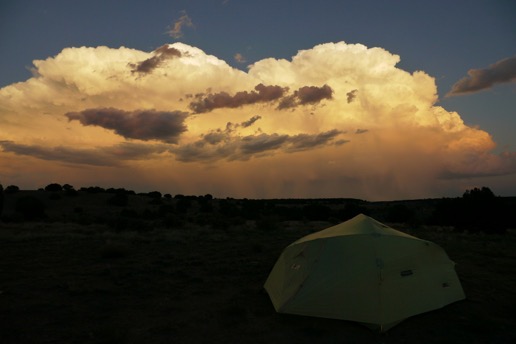
Yes! We got micro-bursted there but not when a storm was in sight.
Wind can be crazy!
Here are a couple of wind graphs from the MESOWEST system of weather stations which are often located in the mountains.

Actual weather station examples - vertical axis is wind speed, horizontal is time. Arrows show the direction and magnitude of the wind at the time shown at their base (on the vertical axis at zero)
LEFT: A strong wind changes direction right after dinner (and more than an hour after sunset)
RIGHT: Just plain crazy winds buffet from every side.
Here's an amusing video clip from a casual raft trip on the San Juan River one Summer. It was pleasantly calm and we were setting up camp when we heard a strange sound coming from the West. Looking down-canyon, something hard to describe was happening to the air around and above a bend in the river: the mountains behind were shimmering and blurry. Blurry? Blurry! Almost like looking out a plane window through the jet exhaust. And there was a slight tint to the air, but not enough to make it a dust storm. We started to batten everything down and then this…

Nylon sags when wet because it literally expands. That's a huge shame because EVERY lightweight tent uses nylon (if it uses woven fabric). All that sagging and wrinkling and dripping and condensation and flapping you experienced people have seen over and over — it's just what nylon does when it gets wet. So... simple: we use the latest generation of lightweight polyester fabrics (which match nylon in strength) and everything works like it's supposed to. You can set your tent up and forget about it until it's time to take it back down. In a word, it PERFORMS. As an added bonus, the polyester also has better UV performance AND it dries faster AND it hold much less water when its wet — I believe the technical term is: SWEET!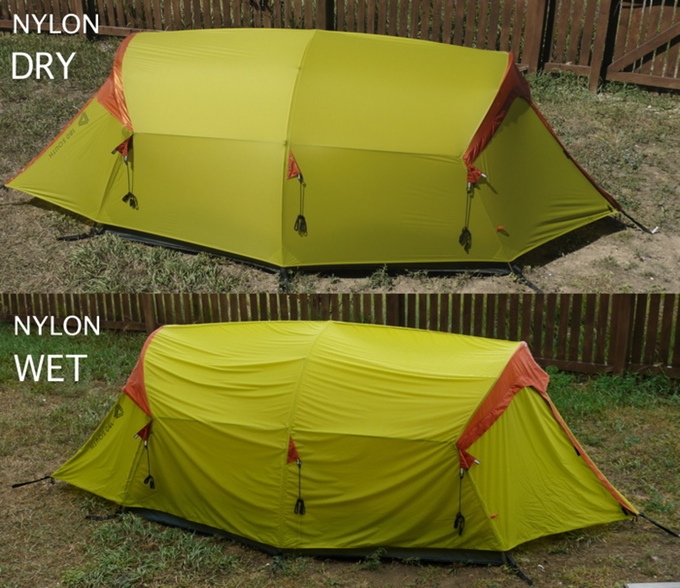
Wet nylon sags and causes drips inside, flapping, and additional condensation
Time to face it: nylon sucks. TheTentLab uses state-of-the-art polyesters — light, strong, better.
WET on the left, DRY on the right, the same. No wait, I said that backward. It's the DRY one on the left and the WET one on the right. (Pretty sure I got that right. It's just hard to tell) NOTE that final models have 2 windows per side, not 3
Here’s a link to a video showing just how fast nylon sags when it gets wet
The stakeout anchors on the MoonLight tents adjust up to a full yard in length. They make getting a good stake in really easy and quick - no picking up and moving the whole tent needed. But where they really shine is when you can't use stakes at all - on bare rock for instance. That's when you find out that using boulders as anchors is seamless and slick. No fiddling or gerrymandering with extra cord needed. It just works.
I have to admit, as a regular tent user, this is one of my favorite features. Most tents have no adjustment whatsoever for their stake points. If there's a rock in the way, tough luck - either mover the whole tent or break out lengths of cord and start rigging. As I designer, that sort of non-solution kind of ticks me off. Using the MoonLight's adjustable anchors, on the other hand, is downright liberating. It's so easy and it works so well - stakes, rocks, logs, they're all easy, quick anchors.
By the way, all MoonLight tents come with a selection of GREAT tent stakes. They're made by DAC and even the smallest one is really hard to bend when hammered into a rock ($40 worth of stakes).
Finding the spot where the stake can go in…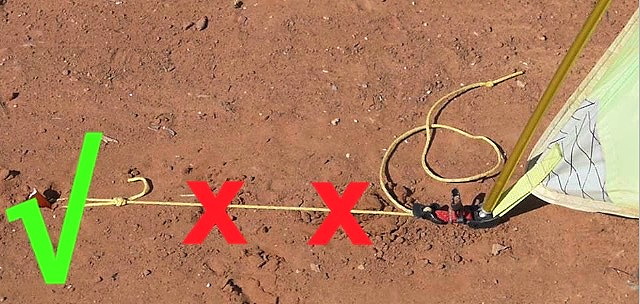
You can put stakes in anywhere within the pie-shaped area shown below OR use rocks instead. EASY!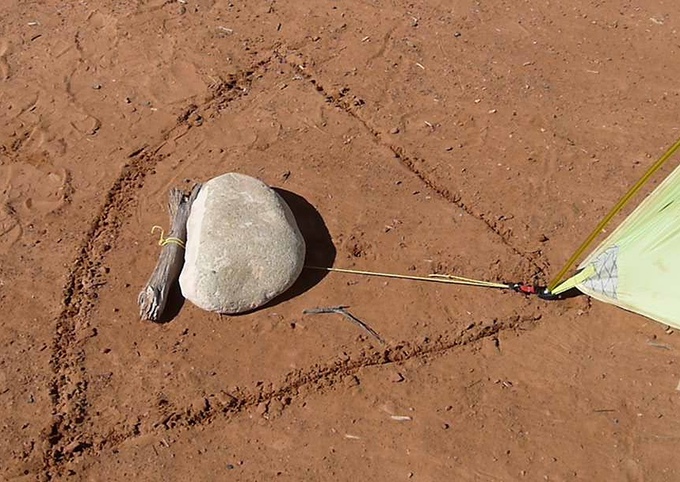
That stick is held by using the end loop as a slip-knot. This is a GREAT way to anchor with rocks. Fast, easy, SLICK!

MoonLights aren't tents where the user's sleeping bag wipes the walls because they press in so much. MoonLights are so roomy they could even be called boxy inside. Here's a neat way to really see how roomy they are — accurate 3D models that you can look at from any angle with human-scaled mannequins inside. Click on the images below to take them for a spin. The MoonLight sidewalls are steep. Sitting or laying down, they don't crowd your feet or head. The MoonLights 3+ and 4+ can comfortably handle professional basketball players (the middle mannequin in the ML3 model below is six foot seven - the average size of a professional basketball player).
The MoonLight 3 & 4 are fantastic tents for kids. I explain more on the "Family Camping" page but these are tents that kids and parents can really enjoy, both for mayhem or sleep.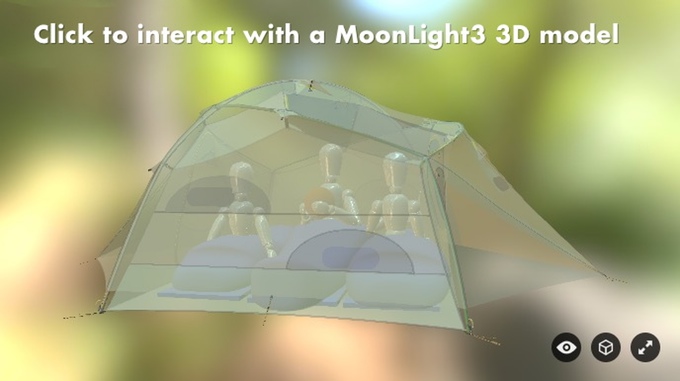
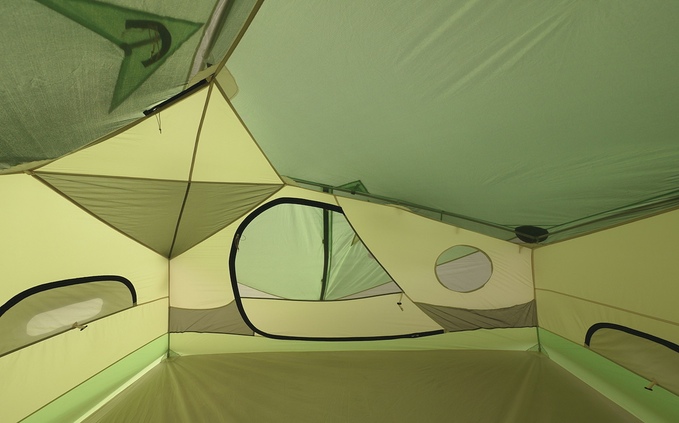
Inside the MoonLight 4 when the rainfly is on. Pockets and ceiling bins and windows, oh my. Note roof zippers to access the vents up top.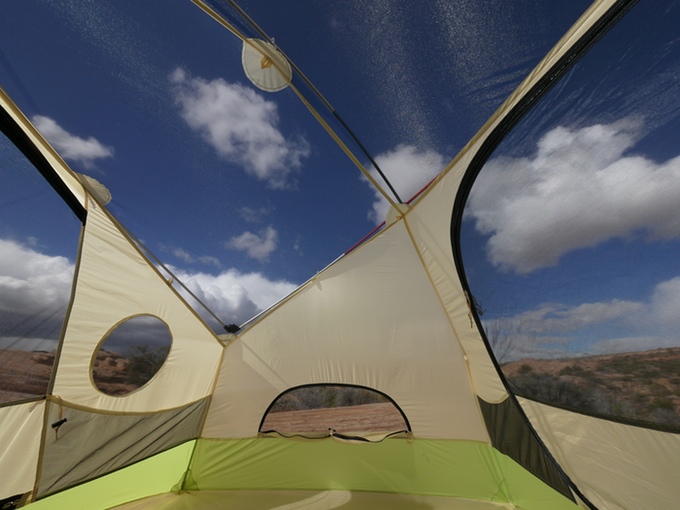
Inside the MoonLight 2 with the rainfly off. Very pleasant sky watching...the ML 3 & 4 views are even bigger.
If you camp in sandy areas, doing river trips or going into any desert, no matter whose tent you use, the zipper is going to fail eventually. The sign is this: when you try to zip it, it doesn't engage all the teeth, it leaves areas unzipped. This is not caused by worn zipper teeth, it's caused by worn zipper sliders (sliders are the little do-hickies you pull to make the teeth mate). You can do a squeeze repair on the sliders and they will work for a short while, but you're playing with fire. Worn sliders have razor sharp inside edges that will destroy the zipper teeth when you back the slider over them. Destroyed teeth mean an expensive zipper replacement repair. My solution: an extra set of sliders already installed to use while you get the worn ones replaced. If your zipper fails to zip closed, don't screw around with a risky repair. Just take the pulls off the old sliders and put them on the fresh sliders waiting neatly at the bottom end of the door zipper. Replace the old worn-out ones inexpensively and at your leisure.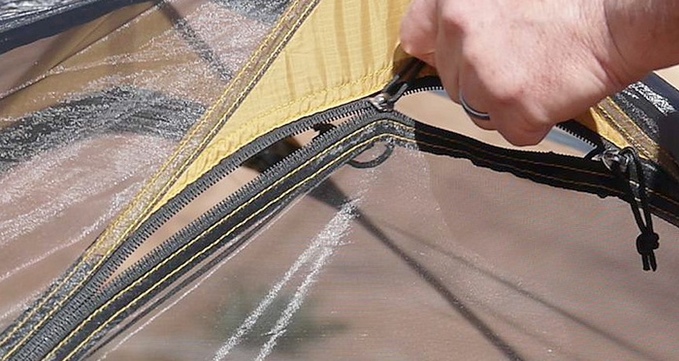
Uh-oh! I hear a mosquito dinner bell. Hope that doesn't happen on a long, buggy river trip... Of course I'm exaggerating. I can't actually hear mosquito dinner bells anymore. Or, for the record, the sound of one hand scratching.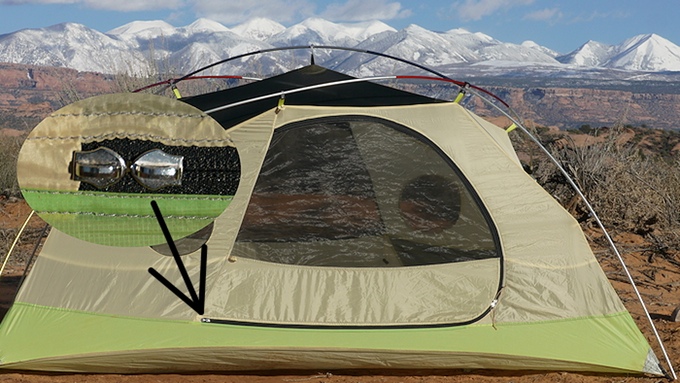
That extra set of sliders weighs just 7 grams per door - 1/4 ounce.
All MoonLight rainflies can be pitched with just the poles. If it's pouring, just pitch the fly, crawl in, lay out your nice dry tent body and clip it up to the poles, unclipping the pole ends from the fly and re-clipping them to the tent corners. All done. Nice and easy like everything about these tents. click the Photo below to watch the fly-only setup video.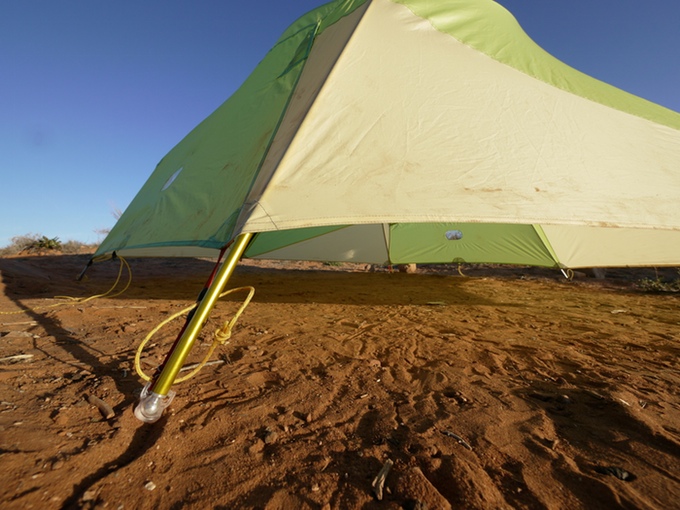
There's the rainfly-to-pole clip on the end of the pole there. It pops on and twists off. Easy peasy.
What to do... the night hasn't cooled yet and you'd like to leave off the rainfly but you know there's a storm coming... Simple: put the fly on and then undo just two buckles and peel it back. If it rains the fly will slide back on in seconds. We may not have invented this feature, but we've perfected it. Thanks to the long adjustment cords on the vestibules, the MoonLight rainflies can be half-on or all the way down on one side. Either way, they re-pitch amazingly quickly and easily. Just the ticket for a 2:00AM downpour. Why can so few other tents do this trick? Because they don't have adjustable stake loops on their vestibules and their geometry won't let the rainfly slide over without undoing the anchors.
You can roll everything up neatly or be as sloppy as you like. It just works.

Every guyline in its place and a place for every guyline. By the way, all MoonLights come pre-rigged with GREAT guylines: 1.5mm Dyneema/Polyester, reflective, with the excellent Phantom cord adjuster on the ends.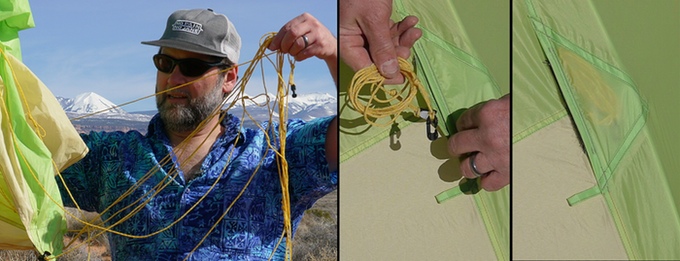
So simple I can do it.
Camping out in extended rain can be challenging. One of its delights is that rainwear pretty much has to sit in a pile in the vestibule where it becomes completely, uniformly soaked. Cold and soaked. MoonLight tents can help. Outside both doors (to the right) are three little loops high up on the tent. You can use those loops to hang rainwear so it has a chance to drip-dry. You're welcome.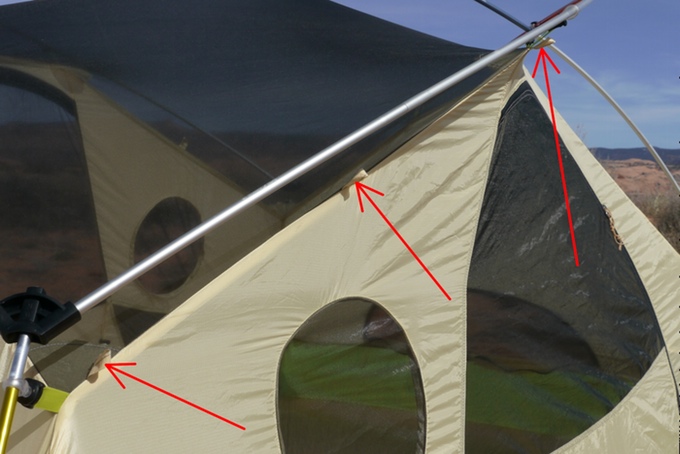
Three little loops (per side): they cost nothing & weigh nothing but boy are they handy
